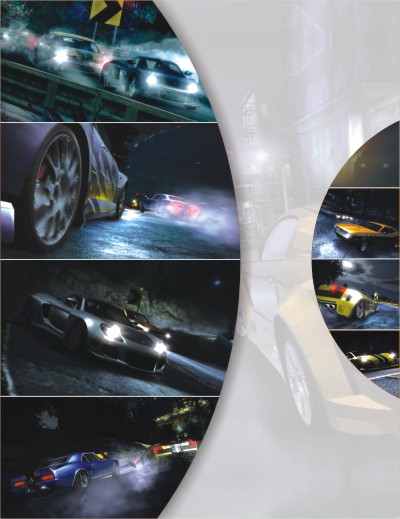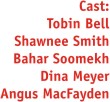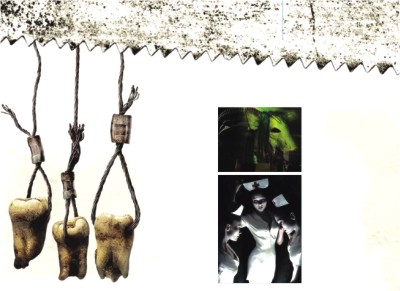
Another year, another Need for Speed to satisfy the scores of car mad freaks out there. This year's version has been named Carbon, after the Carbon Canyon in the game where racers settle their differences by hitting the tarmac. The game was first unveiled in the 2006 E3.
 For the first time in Need for Speed's history this game has a story line that's interesting enough to hold you interest throughout the game. You might argue that Most Wanted had a good story line but by the time you get through the 15 blacklist racers you've already forgotten most of the details of the story. Anyway, Carbon's story starts where Most Wanted ended. There you are in you're BMW M3 GTR with the beloved Sgt. Cross still chasing you. Like Most Wanted you are given a small taster of the BMW before you crash it and it's taken away from you.
For the first time in Need for Speed's history this game has a story line that's interesting enough to hold you interest throughout the game. You might argue that Most Wanted had a good story line but by the time you get through the 15 blacklist racers you've already forgotten most of the details of the story. Anyway, Carbon's story starts where Most Wanted ended. There you are in you're BMW M3 GTR with the beloved Sgt. Cross still chasing you. Like Most Wanted you are given a small taster of the BMW before you crash it and it's taken away from you.
The story seems a bit jumbled right from the start, but the sweet graphics makes the cut scenes worth watching, even if you don't have any idea of what's happening. The story seems to tell you that you've already got a history and rep in Palmont City even before you had gone to Rockport. After you crash you're confronted by Cross whose now a bounty hunter now because he lost his job as a Sergeant thanks to you. But before he can do anything Darius, an old friend and accomplice, comes over and bails you out of trouble. Then comes Nikki, your ex, and then you realize that you're not really welcome in Palmont. From what I could make out, it seems that you've already got a reputation in Palmont as a traitor. The whole premise of the story is for you to quell such allegations and take over the racing scene.
In Most Wanted, you had to cause enough heat with the police and catch the notice of the police and the top racers in the city and take their place in the Blacklist. Here it's all about turf, the more territory you have the better your position in the city. It's like the territorial gang wars from GTA: San Andreas, only instead of using an AK 47, you battle it out in a 3 lap race with your black SLR McLaren. In Carbon the city is divided into four zones. After you've taken enough territory you are challenged by the leader of the gang that controls that area in a final winner take all. There are four main gangs controlled by four people (Kenji, Angie, Wolf, and Darius) from your past and these people aren't really all that happy that you're back.
In terms of the new things offered in the game there are the canyon races where you have to race fast and handle your car like a demon so that you don't fall over the side (akin to Tokyo Drift). Making a return are all the other race type like circuit, sprint etc, including drift which has been brought back and excluding drag which has been taken out. The adrenaline filled police chases are still there but they take a back seat in the game and their place has been replaced by the canyon races.
 When discussing racing the whole new concept of a crew racing with you awaits. In almost all of the races you are allowed one member from your crew who helps you out. These crew members come in the form in of a blocker and a scout. The blocker's job is obvious from its name. It blocks rival racers and lets you race ahead and take first place. The scout's job is to lead you (by leaving a neon multi-colored trail behind) through all the short cuts in a track and lead you into a winner. There are also other crew members like a fabricator who offers you Auto-sculpt (which is a whole new feature). Then there is a mechanic and a fixer whose jobs I have yet to figure out.
When discussing racing the whole new concept of a crew racing with you awaits. In almost all of the races you are allowed one member from your crew who helps you out. These crew members come in the form in of a blocker and a scout. The blocker's job is obvious from its name. It blocks rival racers and lets you race ahead and take first place. The scout's job is to lead you (by leaving a neon multi-colored trail behind) through all the short cuts in a track and lead you into a winner. There are also other crew members like a fabricator who offers you Auto-sculpt (which is a whole new feature). Then there is a mechanic and a fixer whose jobs I have yet to figure out.
The biggest factor that created all the hype about this game is its Auto-sculpt customization feature. In the previous NFS games (Underground, Underground 2, Most Wanted) the option of modding your ride was available. This game takes modding to a whole new level. After fitting a new a bumper, you can actually shape it to your desires and wants. The same is available for the other parts and when you're done you have a one of a kind ride never seen before. Sounds cool huh? It is.
Carbon's graphics are something to praise. I've never really been a fan of EA Games, but in this game they've out done themselves. The detail in the environment and the cars is visually stunning. But there is a complaint, in Underground 1 and 2 the concept of day didn't exist, in Most Wanted the Sun ever sinking was an alien idea and in Carbon the dawn ever taking place is unbelievable. EA doesn't seem to understand the concept of day and night since both of them rarely co-exist in their games. However, being EA's first next-generation game, it seems that Carbon's been made more for XBOX 360s and PS3s than a PS2 or a PC. In the next-gen the graphics are more defined and when racing there's a cool blurring effect that you won't get in a PS2. It's is possible to get that kind a graphics in a PC, but that PC has to be a monster to do that.
The game has a solid racing stable with well over 50 cars on offer. In this game the cars are divided according to type and tier. There are three types of cars, the muscles (the one Mood Dude would pick, guess which car), the tuners and the exotics. The type of car you choose decides how you perform in a race. A muscle is best for acceleration and taking a huge lead, preferably in a sprint race, while a tuner is best for split time handling, preferably in a drift race. Also a good about the cars is that they are divided into tiers. Now a tier 3 car cannot compete with a tier 1 car (unlike Most Wanted, where a heavily modded Mazda could take down a Viper).
In terms of music, like the previous games, Carbon has its own list of tracks playing in the game with a few good songs on it. The voice acting and the use of live actors has made the cut scenes a sweet experience. The fact that there are a lot more cut scenes than before which is a take on making the story a bit more engrossing. You can't say that the cut scenes achieve that but at least you get a lot of eye candy.
All in all the games worth playing but there are a few kinks in it. In the PC version the frame rate is the biggest problem because to achieve that, you would need a hugely high end PC. You can still play the game if you have a decent PC with a good AGP card and good enough amount of RAM. In the PS2 version the games well but when you view the PS3 or XBOX 360 screen-shots the PS2 version falls sadly short. In conclusion the games worth the 20 hours it takes to finish it but the if you aren't a huge fan of racing than it's still a good buy if only to fool around with Auto-sculpt.

 Saw numero uno had it all including large gaping plot holes you could poke an entire movie through. But it did have an ingenious concept that of playing games with people to show them value for life. Macabre but downright engrossing.
Saw numero uno had it all including large gaping plot holes you could poke an entire movie through. But it did have an ingenious concept that of playing games with people to show them value for life. Macabre but downright engrossing.
You can't expect sequels to provide the same a surprise as the concept of the story is rooted into the first one. But the sequels can be a good story when they have decent twists and smart link to the predecessors.
The plot:
Saw III does actually have a plot to twist which sets it apart from most slasher films. Usually we have sacred people running around, discovering things and then discovering that they are dead. Maybe one or two get rescued/make it through alive in the end. Or not. Here the premise is different in the sense that characters or rather victims are made to value life in a very twisted macabre sort of way by playing games that can and often do take their lives.
In Saw II we saw Jigsaw (Tobin Bell) not doing very well. He was dying and decided to take young Amanda (Shawnee Smith) under his wing to continue his work. Saw III picks up with Jigsaw in even worse shape than before, his body breaking down while his moralizing creepiness remains more or less intact. Amanda brings in an unhappy doctor (Bahar Soomekh) to keep Jigsaw alive along enough to see one of his most elaborate games played all the way through. The unhappy doctor has to perform some emergency surgery. Helping to motivate her is the fact that she's been outfitted with an explosive collar tied into Jigsaw's heart monitor, so if he dies, she dies with him.
The subject of this game is Jeff (Angus Macfadyen) is tortured not by the memory of his young son killed by a drunk driver, and his desire for vengeance. Jeff is sent through one of Jigsaw's house of horrors to find "forgiveness." He's confronted with a series of individuals being tortured in various ways who are connected to the hit-and-run death of the couple's young son, testing his level of forgiveness as he must decide whether to risk his own life to save theirs.
 The verdict:
The verdict:
Of course, not the entire story makes sense just like the first two. But this movie cuts in among the other two stories helping to patch up a lot of the holes we had seen before. Plot holes are still there and expect them to be more thoroughly resolved in further sequels.
Tobin Bell is doubtlessly the star of the show and the only one who doe not have to scream. He plays the archvillain Jigsaw delivering a quietly intense and scary performance. It is quite a scary movie despite some critics claiming that it has lost some teeth. It is guaranteed that the only people laughing after this movie are the producers who go to the bank thinking they made three movies in three years each making more money than the last.

PART I
“……. it seemed at last that there were two musics progressing at one time before the seat of Illúvatar, and they were utterly at variance. The one was deep and wide and beautiful, but slow and blended with an immeasurable sorrow, from which its beauty chiefly came. The other had now achieved a unity of its own; but it was loud, and vain, and endlessly repeated; and it had little harmony, but rather a clamorous unison as of many trumpets blaring upon a few notes. And it essayed to drown the other music by the violence of its voice, but it seemed its most triumphant notes were taken by the other and woven into its own solemn pattern.”
J.R.R. Tolkien (The Silmarillion)
How about that for a mythological origin of heavy metal music? In the real world the term “Metal” was first ascribed to music by the herald of the libertines, William S. Burroughs. His actual words were:
“...Heavy Metal People of Uranus wrapped in cool blue mist of vaporized bank notes - And the Insect People of Minraud with metal music"
 Burroughs, William S. (Nova Express)
Burroughs, William S. (Nova Express)
Heavy metal was probably born in the first few notes of Beethoven's 5th symphony, when the genius sacrificed melody for rhythm's sake. This school of thought is one of the major influences behind the evolution of heavy metal. This, along with many other factors, shaped the coarse sound of early electric blues into the extremely creative and honest form of music, known today as heavy metal.
Early Rock 'N' Roll: The 'White' Rock
Since its conception in the early 50's, rock had essentially been nothing but a sickeningly wholesome background sound of puppy love. It had neither the emotional depth of the soul-blues scene, nor the musical craftsmanship of the jazz maestros. It was only something to move your body by, thoughtless, intuitive. The critics were merciless; they ousted rock and roll from the holy temple of music, rock fans were literally pariahs. But they missed two extremely important qualities of rock music: it was unpretentious, and it was packed with unbridled energy. Any youth of any generation could relate with that and thus rock became the music it has always been since: for the young, of the young and by the young.
The first high priest of rock 'n' roll is undoubtedly Bill Haley. History hasn't been kind to him. Elvis Presley and Buddy Holly are revered like saints, their music respected by writers and scholars as well as the record-buying public, yet Bill Haley - who was there before any of them, playing rock & roll before it even had a name - is barely represented by more than a dozen of his early singles, and not even recognized by the average listener, often treated as an anomaly that came and went very quickly.
The central event in Haley's career was the single "Rock Around the Clock" topping the charts for eight weeks in the spring and summer of 1955, an event that most music historians identify as the dawn of the rock & roll era.
For all their energy and greasy hair locks, these rock stars were out there only to have a good time, they had no intention of bringing about any social revolution. The pioneers, who would bring forth socio-political angst through their music, were still in their grammar schools.
After Haley came the all-sweeping Elvis era, and everybody knows everything about that. He isn't a personal favorite, so let us skip ahead to the first band that really showed us how a rock band can be as creative as the old masters of the classical era.
I am talking about The Beatles. Hold on! No need to hold up your moshpitting attitude and snort your nose! They surely have sung their share of sweet syrupy ballads for the girls, but the true talents of The Beatles hide elsewhere. You want psychedelic crazy lyrics? Let's see you top 'I am the Walrus' or 'Glass Onion'. You want progressive? 'Strawberry Fields' should suffice. With 'The White Album' they had produced the heaviest sounding album of that era. You thought Marilyn Manson was disturbing? Well Marilyn took the latter half of his name from the serial killer Charles Manson, who, by the way, started his killing spree influenced by the track 'Helter Skelter' from 'The White Album'. They certainly were no cute gargling boy band.
Other than being the premier proto-progressive rock band (topped only by Pink Floyd), The Beatles had also influenced a generation of musicians who would go on to establish the true form of heavy metal.
After The Beatles, came a band who would personalize the lunatic creativity of that age. They would put so much originality, so much psychedelia into their music; the face of rock music would be changed forever. Led by the moonstruck genius of Syd Barett (who was succeeded by the equally stunning duo Roger Waters and David Gilmour), Pink Floyd created something so unique, that even today it is impossible to assign them one genre.
The Revenge of the Left-outs: Proto-Metal
As the rock 'n' roll music scene erupted across the world, its silly lyrical concepts alienated a certain group of youth. Their retaliation came with a type of music that focused angrily on dissident and alienated themes.
The first blasts of music which were nearly heavy metal in their aggressiveness were emitted by bands the likes of The Kinks, The Who. The Kinks' “You Really Got Me” or The Who's “My Generation” was controversial and abrasive enough for their time, making these two tracks the first proto-metal songs.
One group vented their anger with a blend of loud, distorted blues, which was pioneered by a chaotic band called Blue Cheer, who made grating, droning, grinding blues rock with the aid of deformed amplifiers and an ardor for crudity. They were the vanguard of a range of electric blues bands from Cream to Jimi Hendrix to ZZ Top, and inspired much of the loud rock which followed. They were followed up by an array of bands like Vanilla Fudge, Grand Funk Railroad, MC5, Golden Earring, Atomic Rooster, Cactus, and The Jeff Beck Group. Among these, the most historically important were Iron Butterfly and Steppenwolf because of their co-founding the term “Heavy Metal”, in terms of music. Steppenwolf's biker theme “Born to be Wild” included the lines “Heavy Metal Thunder” and Iron Butterfly named their first album “Heavy”. Iron butterfly's seminal work was their “ In-A-Gadda-Da-Vida”- a 17 minute long masterpiece with a menacing riff.
The second faction of people was the intelligentsia of this experimental music scene. Their progeny still are the creators of the most complex, beautiful and interesting music, clearly distinctive in their use of complex compositional structures, odd time signatures, and intricate and virtuosic instrumental playing.
They were the creators of a genre called progressive rock, which eventually evolved into progressive metal.
The early form came from the psychedelic mind trips of The Beatles and the beautiful lunacies of Pink Floyd. In spite of their immense talent, the form they created lacked any resemblance with proper progressive rock format. The first progressive metal band whose sound we can still relate with the progressive bands of today was King Crimson. If one group is responsible for the whole progressive rock/metal genre, it is King Crimson.
Led by guitarist Robert Fripp, their seminal first album 'In The Court Of The Crimson King', had sketched out a whole new way of musical experimentation for a generation of new musicians. New groups like Camel, ELP (Emerson, Lake and Palmer), Genesis, Yes, Rush took this genre to more exciting dimensions.
Finally, there was a cluster of bands who grew from the surf and garage rock traditions into a technique-oriented format, beginning with half-American Indian guitarist Link Wray, who, basically invented the power chord, and leading through surf guitar champion Dick Dale, whose breakneck speed of single-note staccato picking technique was unrivalled until it entered the repertoires of metal virtuosos like Eddie Van Halen.
By 1969, the influence of these artists had saturated the public consciousness, thus preparing them for the impact of three bands, who would embody the apex of hard rock and heavy metal: Led Zeppelin, Black Sabbath, Deep Purple.
